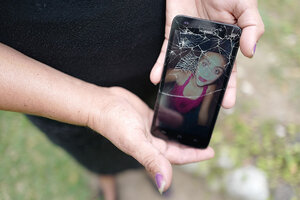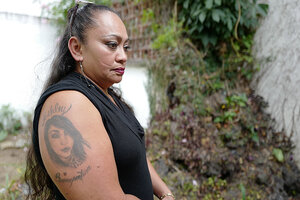Two years after tragedy, can Guatemala rethink child protection?

Vianney Hernández holds a photograph of her daughter Ashley, who died in the 2017 fire at the Hogar Seguro Virgen de la Asunción children's home. Forty-one girls died in a small room they had been locked in as punishment for an attempted escape.
Morena Perez Joachin/Special to The Christian Science Monitor
Guatemala City
Vianney Claret Hernández says she tried everything within her family’s means to help her daughter Ashley thrive. She built a sand-filled punching bag where Ashley could express her anger safely and applied for scholarships for a private school where staff might have more luck keeping her engaged.
On nights when Ashley disappeared from home, Ms. Hernández would jump into action, calling her daughter’s friends or showing up at their front doors.
Finally, when a judge ordered Ashley into a state-run home for youth, Ms. Hernández says she felt it was the right move.
Why We Wrote This
A 2017 fire at a children's home was one of Guatemala's deadliest disasters in 20 years. Setting the stage, advocates say, were deep-seated ideas about young people in need – ideas they're determined to change.
“I had exhausted all of my resources, and I truly believed the state could offer Ashley the psychological support and [educational] training that I couldn’t,” she says.
But on March 8, 2017, one month after entering the Hogar Seguro Virgen de la Asunción, 14-year-old Ashley and 55 other teen girls were trapped when an overcrowded room caught fire. They’d been put there as punishment after trying to escape the home, where many allegedly were abused physically and sexually. Forty-one died from the blaze, including Ashley.
Institution officials and police officers reportedly stood outside the locked door as its turquoise blue turned to charred black, undeterred by the girls’ screams for help. A criminal trial launched last month, but hearings have been largely shielded from the public and media, local journalists say.
“I saw this as a solution, as a place of hope for Ashley,” her mother recounts, eyes brimming as she strokes the arm where she’s tattooed a remembrance to her daughter. She and her husband, a construction worker, are raising their three other children in a poor neighborhood on the outskirts of the city. “But before [her death] and after, it was worse than negligence.”
The grisly blaze spurred an international outcry. But two years after the tragedy, the country’s child-protection system is largely unchanged. The estimated 600 minors held at the “safe home” were dispersed to other institutions. Attempts to boost funding and amend child-protection laws have lagged.
But small, dedicated groups are pushing to change how Guatemala treats minors. It’s the very lack of attention to deeper problems with institutionalization – from abuse and corruption to the poverty that channels many children into the system – that keeps them motivated, advocates say. As much of the world turns away from large group homes toward other solutions, they are determined to help Guatemala keep pace.
“This was a clear sign of how unimportant children and adolescents are for [Guatemalan] society, and even more so the political class,” says Carolina Escobar, director of La Alianza, which runs a residential program for victims of sexual abuse and trafficking. “We don’t have a real protection system.”
The danger in ‘safe homes’
The Virgen de la Asunción safe home, located on the outskirts of the capital in San José Pinula, is near the top of a hill and surrounded by dense forest. Razor wire swirls across the perimeter of the tall, cinder block walls enclosing the complex where girls and boys from infants to teens were meant to be cared for, either mandated by court order or sent by their own families.
The international trend in recent decades has been toward the deinstitutionalization of child protection, relying on alternatives like in-home therapy or foster families. Nearby Nicaragua, for example, has closed scores of homes over the past decade. Guatemala, on the other hand, opened the doors to Virgen de la Asunción, a “macro” institution, in 2010.
“Big institutions like these were very famous in Europe in the 19th century. We are two centuries behind,” says Ms. Escobar, noting that Asunción was meant to house 400 minors but ended up with 600 and 800 at a time. The ideal size of an institution, according to UNICEF, is 24 children. “We aren’t paying attention to the rest of the world, just responding to a very conservative society where children have no voice.”
Advocates say children aren’t prioritized for a long list of reasons, from corruption to stereotypes that view children in need as future gang members who don’t deserve investment. A 2006 academic report found that “the concept of a child as an individual with rights is not commonly accepted” in Guatemala.
Children in large group homes are often at greater risk than those in family settings, says Carlos Carrera, the country representative for UNICEF Guatemala. He rattles off statistics: For every three months that an infant is institutionalized, for example, the child loses up to one month of development. Minors in institutions are six times more likely to be victims of violence.
There are roughly 5,600 minors institutionalized in more than 130 state-run and privately run homes in Guatemala. The vast majority are run by churches, adding challenges in terms of oversight and regulation.
But a broader concern for Mr. Carrera and others is how quickly the system moves children to institutions. About 94 percent of institutionalized children have family who theoretically might be able to take them in. And at least one-third of residents are sent to institutions because of their family’s poverty. Nearly 50 percent of all children in Guatemala suffer from malnutrition.
“The solution to poverty can’t be to separate kids from their family. It’s a double punishment,” Mr. Carrera says. “The institutions reflect the lack of a social protection system that supports families in poverty or other dynamics like domestic violence.”
From criminalization to protection
Most of the teens killed at Virgen de la Asunción weren’t there for crimes but for their own protection, says Judge Juan Orlando Calderón, who had sent scores of minors there and to other homes. Although he did get complaints about the home, he says they weren’t nearly as serious as the accusations that have come out since the tragedy, like reports of sexual and physical assault.
Last year he issued an unprecedented sentence ordering the Office of the Attorney General to formalize a lifelong pension requirement for all the survivors of the fire that could be applied to future cases of state wards being mistreated.
Since then he and his family have received death threats. Many Guatemalans have blamed the tragedy on the victims themselves, portraying them as hard to control, or their families. Some social commentary has gone so far as to claim the deaths were a good thing – 41 fewer criminals for Guatemala to deal with down the line.
“The biggest achievement to come out of this tragedy is helping society see this as a protection process for victims, not the criminalization of children,” Judge Calderon says.
In the Ministry of Social Welfare, Angie Villalobos, who oversees foster-family programming, saw the fire as the moment to take action on “responsible deinstitutionalization.”
“There were about 15-25 foster families across the entire country,” Ms. Villalobos says. “There wasn’t a lot of interest or credibility in the program.”
The disaster was an impetus to build up the program – educating judges on the benefits of placing children in family settings instead of institutions and trying to recruit interested families.
“In a home for children, there may be food and clothes, but there’s little personal attention,” she says. Guatemala currently has 90 foster families, and Villalobos is traveling to far-flung states to work with local governments to recruit more. Most are interested in taking in infants and small children, assuming that the older children are dangerous.
“Deinstitutionalization is a long process, but I feel like we’re on the right path,” she says.
Mr. Carrera from UNICEF says the organization is working with the government to bolster other alternatives as well, such as a pilot program to bring therapy and other services directly into families’ homes.
‘One day we will see justice’
When Ms. Hernández saw news about the fire on TV, her first thought was that surely Ashley had escaped. “That was just her nature; she was a rebel,” she says. But she was still panicked, begging neighbors for money to travel to the home. Once she arrived, it was chaos: No official information was shared with families, and many parents and journalists were lying on their stomachs trying to peek under the black metal gate outside the home. Families started going to nearby hospitals – and the morgue – based on hope and instinct.
One group of four women, now known as Colectivo 8 Tijax, was moved by what they saw as government apathy. They began tracking the names of girls who were hospitalized, either in Guatemala or abroad, or declared dead and sharing that information with desperate families.
They were at the morgue for 22 days. “We put out the first official list of dead,” says Maria Peña, one of the group’s members. She has spent years working with street children, many of whom she says escaped abuse in homes like Asunción. “Even the morgue was asking us for information…. We got calls from government officials asking us how to tell families that their daughters were dead.”
Since then, the collective has assisted families with their legal battles and continued investigating the home and circumstances around the blaze.
“We’re fighting to individualize these cases, make sure the government can’t just wash their hands of this and move on,” says Stef Arreaga, another member. Their discoveries included that Ashley may have been molested in the lead-up to the fire and that she died in the home, not a hospital as Ms. Hernández had been told.
“Our work won’t be over until we can transform public policy around children” to make them a priority, says member Mayra Jiménez.
Ms. Hernández says justice is what she’s seeking.
“Justice will help me believe this tragedy won’t repeat itself,” she says, adding that “Ashley is with me.”
“The saddest thing in life is to lose a child. The government took away 41 of them.”


